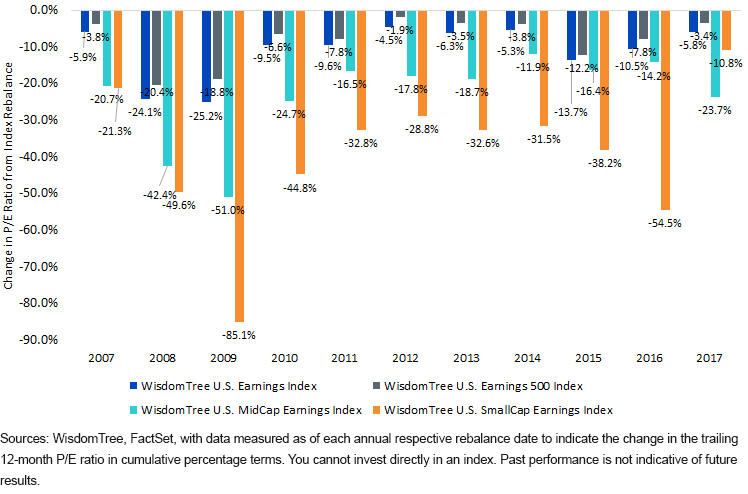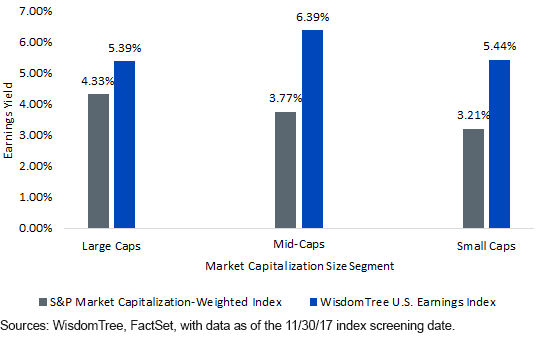11 Consecutive Years of Lowering P/E Ratios … and Counting!


Most of our discussions these days start with some level of concern—odd with U.S. equity markets at or near record highs. Yet, because U.S. equities have done so well and the perceived risk within them has been so low, there is a feeling that this party simply cannot go on forever.
We Focus on What We Know
None of us knows exactly when a correction will come—we hear a lot of investors directly telling us that they have cash to deploy into the market when such a correction comes to pass. But certain statistics, like price-to-earnings (P/E) ratios, are much easier to find. Commonly, we’ll hear that the U.S. equity market has become or is becoming expensive, and for that reason, price levels will have to drop. Those with experience have learned—sometimes the hard way—that:
- An equity market can remain more expensive than recent history might suggest it should for an extended period. Additionally, factors such as interest rates or inflation can undergo regime shifts, changing the levels of what might be perceived as “fair” valuations. People will likely always love the concept of the single-digit P/E ratio, but rarely do they connect it with the fact that—when this occurred on the S&P 500 Index—U.S. interest rates were in double-digit territory. In fact, on March 9, 2009, the recent global financial crisis low, the P/E ratio on that Index was 11.2x.1
Valuation really isn’t a great predictor of how equity markets might behave in the short term, but for those interested in the longer term, we believe it can have major implications.
The Relationship between the Earnings Yield and the Potential Real Returns
In his book The Future for Investors, Professor Jeremy Siegel focused on equities as real assets and indicated that, over a variety of long time frames, the earnings yield on an equity market was very close to the long-term, after-inflation return that market generated over time. Simply put, this tells us the following:
- Higher earnings yields (or lower P/E ratios) have been associated with higher real returns over long periods.
- Lower earnings yields (or higher P/E ratios) have been associated with lower real returns over long periods.
The bottom line: If new dollars are being invested in U.S. equities in an environment where the S&P 500 Index has a P/E ratio of slightly more than 22.0x, that is associated with an earnings yield of approximately 4.5%. U.S. mid-caps, with their P/E ratio of nearly 25.0x, would have an earnings yield of around 4.0%, and U.S. small caps, with a P/E around 29.0x, would have an earnings yield of about 3.4%. The next 10-year period—at least if history is any guide—may look MUCH different from the last one.2
If we’ve paid attention, history has shown us this principle before. On March 23, 2000, the S&P 500 Index had a P/E ratio of 30.6x, and over the subsequent 10 years, its average annual total return was down almost 1% per year. The 10 years leading up to March 23, 2000, saw returns of more than 18.2% per year.
How WisdomTree’s Earnings Indexes Embody the Principle of “Modern Alpha”
WisdomTree launched its U.S. earnings family of Indexes on February 1, 2007, nearly 11 years ago. Over that period, the approach has been termed “fundamental weighting,” “smart beta” or even “modern-alpha,” but the overarching goal has been the same all along: to unshackle the investor from needing to invest at whatever the market’s earnings yield is by rebalancing annually with a process aimed at actually raising the earnings yield compared to a similar market cap-weighted Index.
- Market capitalization-weighted indexes are “valuation takers” in that they do not employ any techniques that might tilt weight away from more expensive stocks.
- WisdomTree’s Earnings Indexes are “valuation makers” in that they employ a relative value rebalance annually, tilting away from stocks whose share prices have outperformed their earnings growth.
The 11 Consecutive Rebalances of Lower P/E Ratios Across Broad, Large, Mid- and Small Size Segments

- Each of the WisdomTree U.S. Earnings Indexes weights stocks on the basis of core earnings, a process that has seen 44 (4 Indexes x 11 annual rebalances) P/E ratio reductions over the live track record.
- Within the WisdomTree U.S. MidCap Earnings and SmallCap Earnings Indexes, there have tended to be some rather large reductions in P/E ratios, driven predominantly by the elimination of exposure to firms with negative earnings. We’ve written before about how negative earnings for an index may in fact raise the P/E ratio by lowering the trailing 12-month earnings per share, and this tends to be a larger issue for mid-caps and small caps than for large caps.
Earnings Yields: Earnings Family vs. Market Cap-Weighted Benchmarks

While by no means does a higher earnings yield ensure outperformance, we believe that it can be one important factor that may lead to a chance of improved returns over the long haul.
Conclusion: WisdomTree’s U.S. Earnings Indexes Answer One of the Biggest Concerns Today
On the subject of U.S. equity market valuation, no investors are telling us that they’d prefer to invest at ever-higher multiples, but by the same token, most U.S. investors are heavily exposed to U.S. equities in various ways. WisdomTree’s U.S. Earnings Indexes are interesting in that they provide U.S. equity exposure while looking to mitigate the risk of the seemingly ever-rising P/E ratios to which we’ve become accustomed.
1Source: Bloomberg.
2Source for paragraph: Bloomberg, with data as of 12/7/17.

Christopher Gannatti began at WisdomTree as a Research Analyst in December 2010, working directly with Jeremy Schwartz, CFA®, Director of Research. In January of 2014, he was promoted to Associate Director of Research where he was responsible to lead different groups of analysts and strategists within the broader Research team at WisdomTree. In February of 2018, Christopher was promoted to Head of Research, Europe, where he was based out of WisdomTree’s London office and was responsible for the full WisdomTree research effort within the European market, as well as supporting the UCITs platform globally. In November 2021, Christopher was promoted to Global Head of Research, now responsible for numerous communications on investment strategy globally, particularly in the thematic equity space. Christopher came to WisdomTree from Lord Abbett, where he worked for four and a half years as a Regional Consultant. He received his MBA in Quantitative Finance, Accounting, and Economics from NYU’s Stern School of Business in 2010, and he received his bachelor’s degree from Colgate University in Economics in 2006. Christopher is a holder of the Chartered Financial Analyst Designation.

